check engine HONDA PASSPORT 2002 2.G User Guide
[x] Cancel search | Manufacturer: HONDA, Model Year: 2002, Model line: PASSPORT, Model: HONDA PASSPORT 2002 2.GPages: 294, PDF Size: 3.97 MB
Page 73 of 294
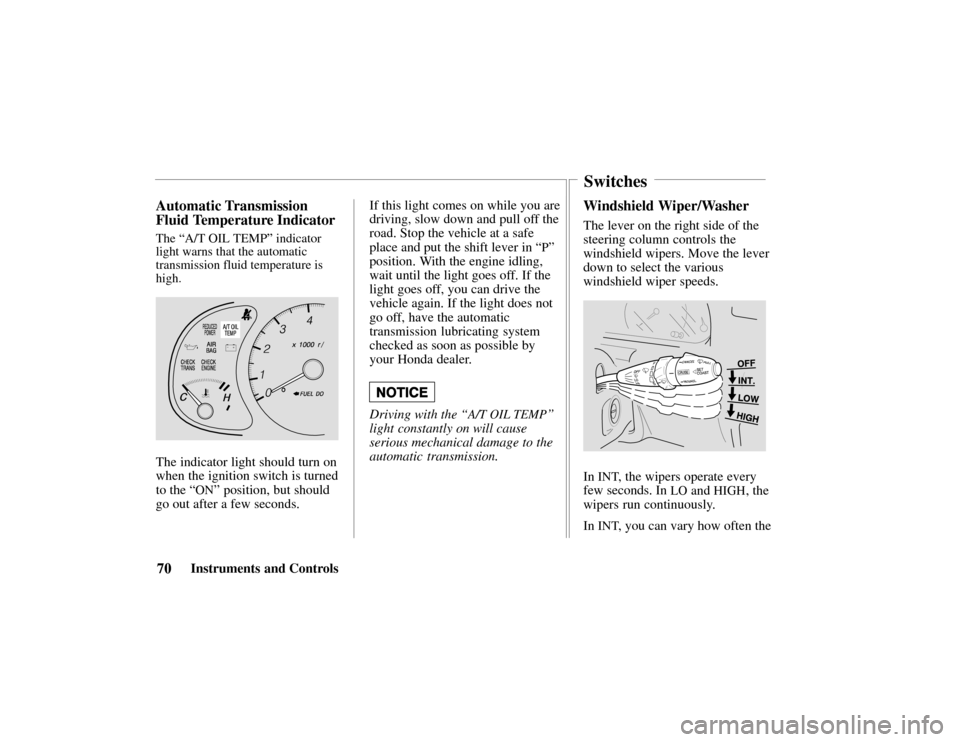
70Instruments and Controls
Automatic Transmission
Fluid Temperature Indicator
The “A/T OIL TEMP” indicator
light warns that the automatic
transmission fluid temperature is
high.
The indicator light should turn on
when the ignition switch is turned
to the “
ON” position, but should
go out after a few seconds. If this light comes on while you are
driving, slow down and pull off the
road. Stop the vehicle at a safe
place and put the shift lever in
“
P”
position. With the engine idling,
wait until the light goes off. If the
light goes off, you can drive the
vehicle again. If the light does not
go off, have the automatic
transmission lubricating system
checked as soon as possible by
your Honda dealer.
Driving with the “
A/T OIL TEMP”
light constantly on will cause
serious mechanical damage to the
automatic transmission.
Windshield Wiper/Washer
The lever on the right side of the
steering column controls the
windshield wipers. Move the lever
down to select the various
windshield wiper speeds.
In INT, the wipers operate every
few seconds. In
LO and HIGH, the
wipers run continuously.
In
INT, you can vary how often the
Switches
Page 74 of 294
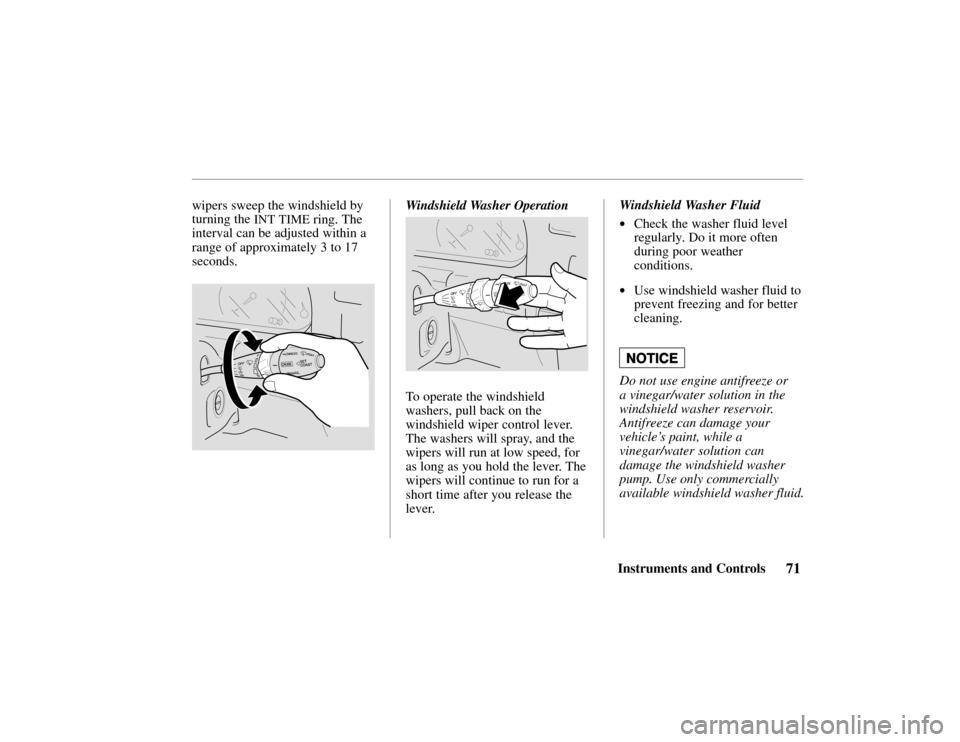
71Instruments and Controls
wipers sweep the windshield by
turning the
INT TIME ring. The
interval can be adjusted within a
range of approximately 3 to 17
seconds.
Windshield Washer Operation
To operate the windshield
washers, pull back on the
windshield wiper control lever.
The washers will spray, and the
wipers will run at low speed, for
as long as you hold the lever. The
wipers will continue to run for a
short time after you release the
lever. Windshield Washer Fluid
•Check the washer fluid level
regularly. Do it more often
during poor weather
conditions.
•Use windshield washer fluid to
prevent freezing and for better
cleaning.
Do not use engine antifreeze or
a vinegar/water solution in the
windshield washer reservoir.
Antifreeze can damage your
vehicle’ s paint, while a
vinegar/water solution can
damage the windshield washer
pump. Use only commercially
available windshield washer fluid.
Page 81 of 294

78Instruments and Controls
3 (Third) — When operating your
vehicle on slippery roads, on a
long descending slope, or on a
road with many sharp curves, you
will want to use engine braking.
At this time, put the shift lever
into this range.
2 (Second) — You may choose this
position when traveling down a
moderate grade where you want to
slow down a little without using
the brake itself. Change back to
the “
D” position to return to
normal driving. With the shift
lever in “2, ” the vehicle will start
in first gear and automatically shift
to second gear.
L (First) — This position may be
selected for maximum braking
down severe grades. Return the
selector lever to the “
D” position
to resume normal driving. It is
possible to move the lever into first gear at any speed. However,
the transmission will not actually
shift to first gear until vehicle
speed is below 35 mph (Power
Mode) or 25 mph (Normal Mode).
When starting out in “L,” the
transmission will not upshift.
Starting — Start the engine with
the lever in the “P” or “N”
position. It will not start in any
other position. If it does, have
your vehicle checked by your
Honda dealer.
Always apply the foot brake
before shifting into any driving
position. This prevents the vehicle
from creeping.
Do not press the accelerator pedal
while shifting from “
P” or “N” to
any driving position.
Shift Lock — As a safety measure
for vehicles with an automatic
transmission, you cannot shift
from “
P” (Park) position into any
other position unless the brake
pedal is depressed when the key
switch is in the “
ON” position or
the engine is running.
The shift lever may not move if
the pushbutton on the shift lever is
pressed before the brake pedal is
depressed. In this case, release
the pushbutton, press the brake
pedal and try again.
If the shift lever won’ t move from
the “
P” position even when these
instructions are followed, perform
the following steps:
Page 82 of 294

79Instruments and Controls
1. Check that the parking brake
is fully applied.
2. Turn the key switch to “
ACC”
position.
3. Move the shift lever from “P”
to “
N” position, depress the
brake pedal, and start the
engine again.
4. Operate the shift lever.
Have the transmission checked by
your Honda dealer as soon as
possible.
Driving Tips
Before going down a steep or long
grade, reduce speed and shift the
transmission into a lower gear or
range to control the vehicle ’s
speed. This will provide engine
braking to help slow the vehicle.
Try not to hold the brake pedal
down too long or too often. This
could cause the brakes to get hot
and not work properly.
Downshifting to a lower gear is
especially important when towing
a trailer in mountainous terrain.
Do not hold the vehicle on a hill
by pressing on the accelerator. Do
not press on the accelerator pedal
and brake pedal at the same time.
Either of these actions can
overheat the automatic
transmission and cause damage. Always keep your foot off the
accelerator pedal when shifting
from “P” or “N” to another gear.
Do not shift to “P” (Park) when
the vehicle is moving; you could
damage the automatic
transmission. Always come to a
complete stop.
Be careful that you do not exceed
the following maximum allowable
speeds when accelerating. mph (km/h)
RangeAutomatic TransmissionRange“L”“2”“3”
“2H”35 (56)65
(105)–
“4H”35 (56)65
(105)65
(105)
“4L”15 (24)30 (48)50 (81)
Page 158 of 294
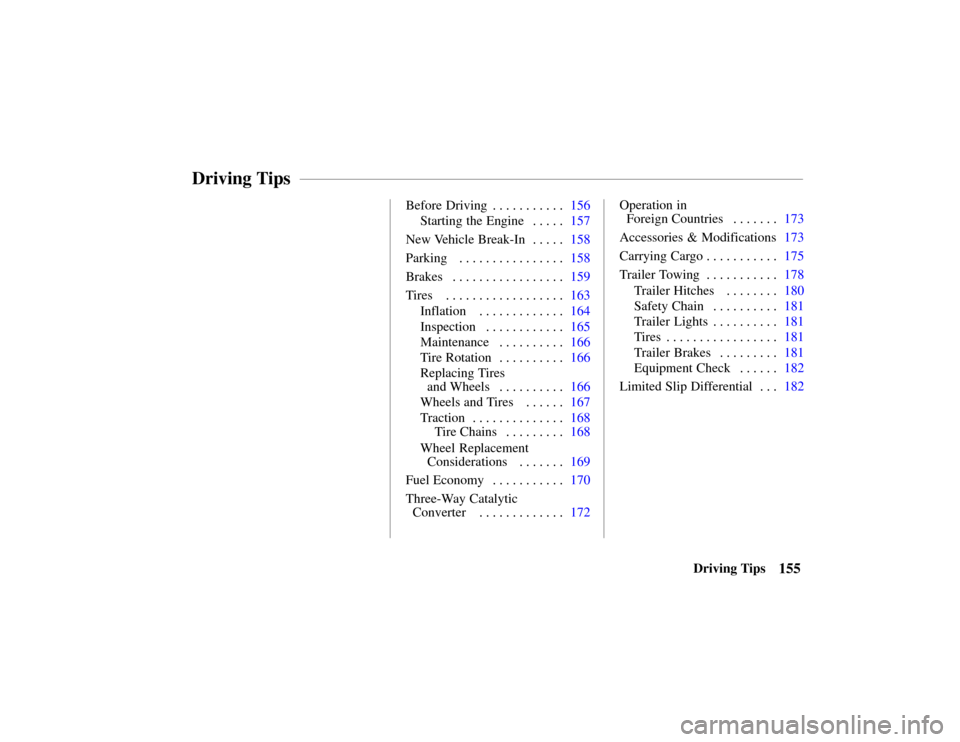
155Driving Tips
Before Driving156
. . . . . . . . . . .
Starting the Engine157 . . . . .
New Vehicle Break-In 158 . . . . .
Parking 158 . . . . . . . . . . . . . . . .
Brakes 159 . . . . . . . . . . . . . . . . .
Tires 163 . . . . . . . . . . . . . . . . . .
Inflation 164 . . . . . . . . . . . . .
Inspection 165 . . . . . . . . . . . .
Maintenance 166 . . . . . . . . . .
Tire Rotation 166 . . . . . . . . . .
Replacing Tires
and Wheels 166 . . . . . . . . . .
Wheels and Tires 167 . . . . . .
Traction 168 . . . . . . . . . . . . . .
Tire Chains 168 . . . . . . . . .
Wheel Replacement
Considerations 169 . . . . . . .
Fuel Economy 170 . . . . . . . . . . .
Three-Way Catalytic
Converter 172 . . . . . . . . . . . . . Operation in
Foreign Countries 173
. . . . . . .
Accessories & Modifications173
Carrying Cargo175 . . . . . . . . . . .
Trailer Towing 178 . . . . . . . . . . .
Trailer Hitches 180 . . . . . . . .
Safety Chain181 . . . . . . . . . .
Trailer Lights181 . . . . . . . . . .
Tires181 . . . . . . . . . . . . . . . . .
Trailer Brakes181 . . . . . . . . .
Equipment Check182 . . . . . .
Limited Slip Differential 182 . . .
Driving Tips
Page 160 of 294

157Driving Tips
switch is turned to the “
ON”
or “
START” position.
5. Check all gauges (including the fuel gauge).
6. Release the parking brake (and make sure the “
BRAKE”
light turns off).
See related topics in this manual if
you find any problems.
Starting the Engine
1. Apply the parking brake.
2. Manual Transmission: Press
the clutch pedal to the floor
and shift the transmission to
the Neutral position. Hold the
clutch pedal to the floor while
you are starting the engine. A
starter safety switch keeps the
starter from operating if the
clutch pedal is not fully
depressed. Automatic Transmission:
Place the shift lever in “P”
or “N” position (“P” is
preferred). A starter safety
switch prevents the starter
from operating if the shift
lever is in any drive position.
If it is necessary to restart the
engine with the vehicle
moving, place the shift lever
in “N” (never in “P”).
3. Do not touch the accelerator pedal. Start the engine by
turning the ignition switch to
“
START.”
If the engine does not start in
10 seconds, wait 15 seconds to let
the starter cool down. Then crank
the engine at wide open throttle
for a maximum of 10 seconds. If
the engine still does not start, wait
another 15 seconds and repeat the
entire procedure. Do not crank the engine for more
than 10 seconds at a time. Wait 15
seconds before trying again.
4. Return the ignition switch to
the “
ON” position as soon as
the engine starts.
5. Apply the regular brakes and shift into the proper gear.
Release the parking brake and
brake pedal and drive off.
In models with an automatic
transmission, you cannot shift
from “P” (Park) position to
any other position unless the
brake pedal is applied.
Page 161 of 294
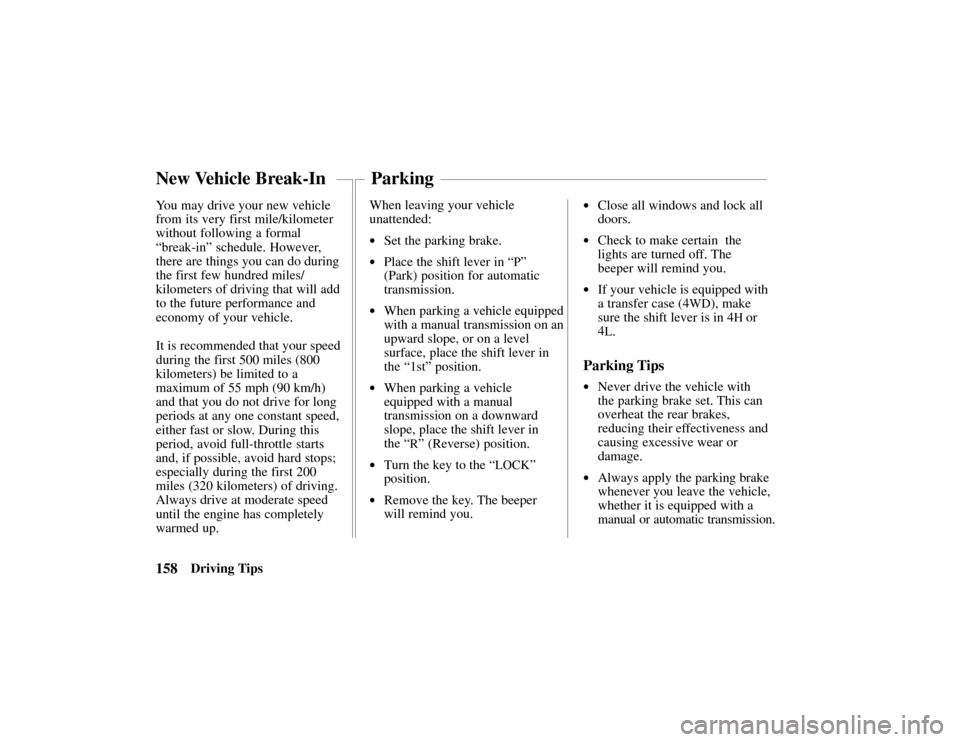
158Driving Tips
You may drive your new vehicle
from its very first mile/kilometer
without following a formal
“break-in” schedule. However,
there are things you can do during
the first few hundred miles/
kilometers of driving that will add
to the future performance and
economy of your vehicle.
It is recommended that your speed
during the first 500 miles (800
kilometers) be limited to a
maximum of 55 mph (90 km/h)
and that you do not drive for long
periods at any one constant speed,
either fast or slow. During this
period, avoid full-throttle starts
and, if possible, avoid hard stops;
especially during the first 200
miles (320 kilometers) of driving.
Always drive at moderate speed
until the engine has completely
warmed up.
When leaving your vehicle
unattended:
•Set the parking brake.
•Place the shift lever in
“P”
(Park) position for automatic
transmission.
•When parking a vehicle equipped
with a manual transmission on an
upward slope, or on a level
surface, place the shift lever in
the “1st” position.
•When parking a vehicle
equipped with a manual
transmission on a downward
slope, place the shift lever in
the “
R” (Reverse) position.
•Turn the key to the “LOCK”
position.
•Remove the key. The beeper
will remind you.
•Close all windows and lock all
doors.
•Check to make certain the
lights are turned off. The
beeper will remind you.
•If your vehicle is equipped with
a transfer case (4
WD), make
sure the shift lever is in 4
H or
4
L.
Parking Tips
•Never drive the vehicle with
the parking brake set. This can
overheat the rear brakes,
reducing their effectiveness and
causing excessive wear or
damage.
•Always apply the parking brake
whenever you leave the vehicle,
whether it is equipped with a
manual or automatic transmission.
New Vehicle Break-InParking
Page 163 of 294
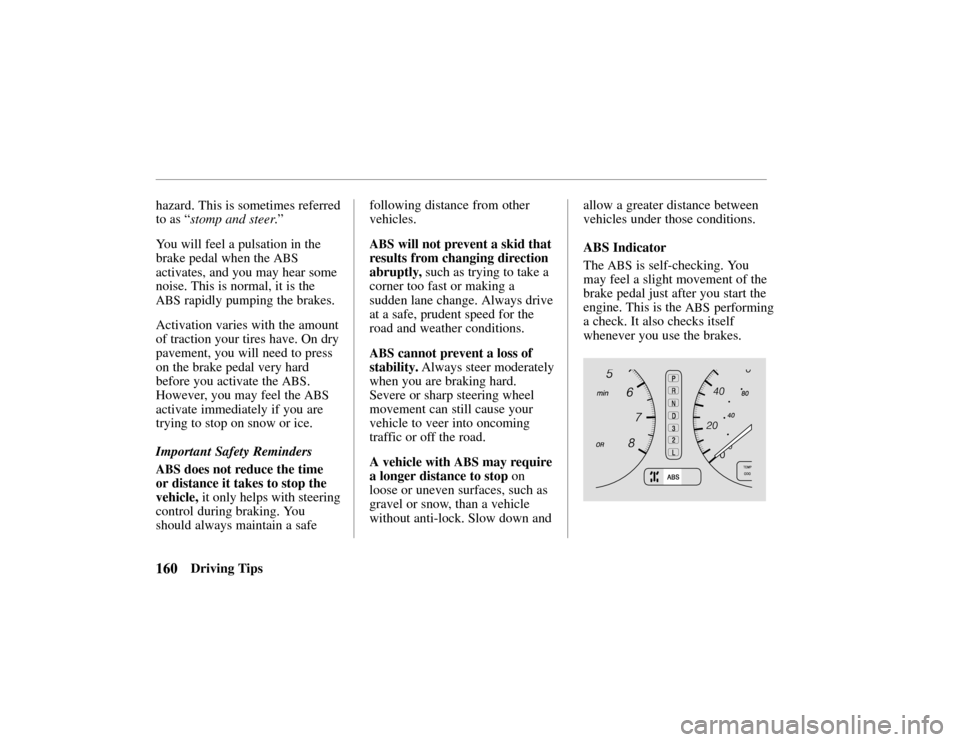
160Driving Tips
hazard. This is sometimes referred
to as “stomp and steer
.”
You will feel a pulsation in the
brake pedal when the
ABS
activates, and you may hear some
noise. This is normal, it is the
ABS rapidly pumping the brakes.
Activation varies with the amount
of traction your tires have. On dry
pavement, you will need to press
on the brake pedal very hard
before you activate the
ABS.
However, you may feel the
ABS
activate immediately if you are
trying to stop on snow or ice.
Important Safety Reminders
ABS does not reduce the time
or distance it takes to stop the
vehicle, it only helps with steering
control during braking. You
should always maintain a safe following distance from other
vehicles.
ABS will not prevent a skid that
results from changing direction
abruptly, such as trying to take a
corner too fast or making a
sudden lane change. Always drive
at a safe, prudent speed for the
road and weather conditions.
ABS cannot prevent a loss of
stability. Always steer moderately
when you are braking hard.
Severe or sharp steering wheel
movement can still cause your
vehicle to veer into oncoming
traffic or off the road.
A vehicle with
ABS may require
a longer distance to stop on
loose or uneven surfaces, such as
gravel or snow, than a vehicle
without anti-lock. Slow down and allow a greater distance between
vehicles under those conditions.
ABS Indicator
The
ABS is self-checking. You
may feel a slight movement of the
brake pedal just after you start the
engine. This is the
ABS performing
a check. It also checks itself
whenever you use the brakes.
Page 166 of 294

163Driving Tips
distances will be longer and
vehicle control more limited.
While driving on a surface with
reduced traction, avoid maneuvers
involving sudden steering,
acceleration, or braking (including
engine braking due to shifting to
lower gear), that could cause the
tires to skid.
Drivers may not realize the
surface is slippery until the
vehicle is skidding.
Learn to recognize warning
clues—such as enough water or
ice on the road to make a
“mirrored surface”—and slow
down when there is any doubt.
Also see “Traction” under “Tires”
in this section.
Rapid slowing down or
speeding-up can cause loss
of control on slippery
surfaces. If you crash, you
can be injured.
Use extra care when driving
on slippery surfaces.
To safely operate your vehicle,
your tires must be the proper type
and size, in good condition with
adequate tread, and correctly
inflated. The following pages give
more detailed information on how
and when to check air pressure,
how to inspect your tires for
damage and wear, and what to do
when your tires need to be
replaced.
Using tires that are excessively
worn or improperly inflated can
cause a crash in which you
can be seriously hurt or killed.
Follow all instructions in this
owner’s manual regarding tire
inflation and maintenance.
Tires
Page 174 of 294

171Driving Tips
air cleaner, so it’
s important to
replace the air cleaner filter at
required intervals. See “Care and
Maintenance.” A dirty air cleaner
filter reduces engine performance
and can waste fuel.
Air Conditioning
Turn off the air conditioning when
it is not needed. The air
conditioning compressor is not on
in this position and the reduced
engine load can improve fuel
economy.
Tuned Engine
An engine that is properly
maintained will provide better
fuel economy than one that is not.
One misfiring spark plug will cut
fuel economy significantly, and
will make a difference in the
amount of pollution emitted from
your vehicle. Excessive Weight
Fuel economy is related to the
work the engine must do. The
heavier the load, the more fuel it
takes to run your vehicle. Keep
weight to a minimum by removing
unnecessary luggage or cargo.
Tire Inflation
Underinflation not only causes
needless tire wear but can also
waste fuel. It’
s a good idea to
check tire pressure often and keep
your tires inflated to the pressures
shown on the tire placard located
on the driver ’s doorjamb. Wheel Alignment
Improper alignment will cause the
front tires to roll at an angle that
will result in faster tire wear. It
takes power to overcome this
improper alignment, which, in
turn, wastes fuel.
Use of 4-Wheel Drive
In normal driving, put the
4WD-2WD switch in the 2WD
position.